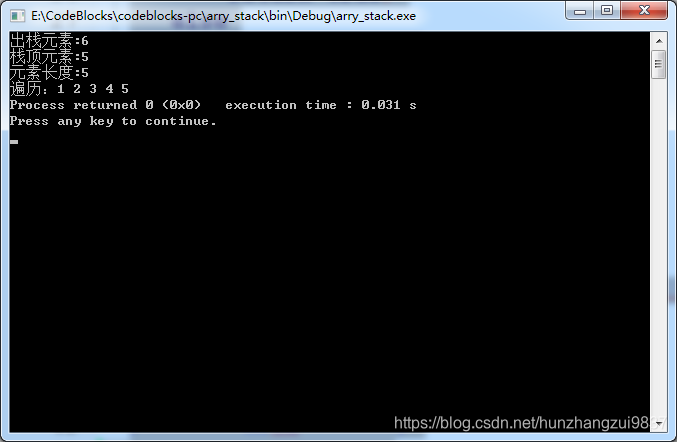c/c++ 陣列實現棧
阿新 • • 發佈:2018-11-13
方法一:結構體實現
#include <iostream> using namespace std; typedef struct{ int d[10]; int top; }Stack; /****初始化一個棧*****/ void init(Stack *s){ s->top=-1; } /****判斷是否為空 ****/ bool em(Stack *s){ if(-1==s->top) return true; else return false; } /****判斷是否為滿 ****/ bool full(Stack * s){ if(9==s->top) return true; else return false; } /*******入棧*******/ bool push(Stack *s,int a){ if(full(s)) //滿了就不能入棧 return false; else{ s->top++; //指標先加 s->d[s->top]=a;//再把資料存進對應的“格子” return true; } } /*******出棧*******/ int pop(Stack *s){ if(em(s)) //空的當然不能出棧 return -1; else{ int tmp=s->d[s->top]; //把棧頂元素付給中間變數 s->top--; //指標減一 return tmp; } } /****取棧頂元素****/ int top(Stack *s){ int a; if(em(s)) //同理空棧沒有元素就不行 return false; else{ a=s->d[s->top]; //把棧頂的元素賦值即可 return a; } } /****取有效元素長度****/ int len(Stack *s){ return s->top+1; } /*****遍歷*****/ void ergodic(Stack *s){ cout <<"遍歷:"; for(int i=0;i<=s->top;i++) cout << s->d[i]<<" "; } int main(){ Stack s; int a,lens; init(&s); push(&s,1); push(&s,2); push(&s,3); push(&s,4); push(&s,5); push(&s,6); int p =pop(&s); a = top(&s); //取棧頂元素 lens = len(&s); //長度 cout <<"出棧元素:"<<p<< endl; cout <<"棧頂元素:"<<a<< endl; cout <<"元素長度:"<<lens<< endl; ergodic(&s); //遍歷 return 0; }
測試:

方法2:封裝成class
#include <iostream> #define MAX 10 using namespace std; class Stack{ private: int top; int a[MAX]; public: Stack(); bool Empty(); bool full(); bool push(int a); int pop(); bool bianli(); }; Stack::Stack(){ this->top = -1; } bool Stack::Empty(){ if(this->top==-1) return true; return false; } bool Stack::full(){ if(this->top==9) return true; return false; } bool Stack::push(int a){ if(full()) return false; this->top++; this->a[this->top] = a; return true; } bool Stack::bianli(){ if(Empty()) return false; for(int i=0;i<=this->top;i++){ cout << this->a[i]<<" "; } return true; } int Stack::pop(){ if(Empty()) return false; int a = this->a[this->top]; this->top--; return a; } int main() { Stack s; s.push(1); s.push(2); s.push(3); s.push(4); int b = s.pop(); cout <<"出棧元素:"<< b << endl; cout <<"遍歷:"; s.bianli(); return 0; }
測試:

